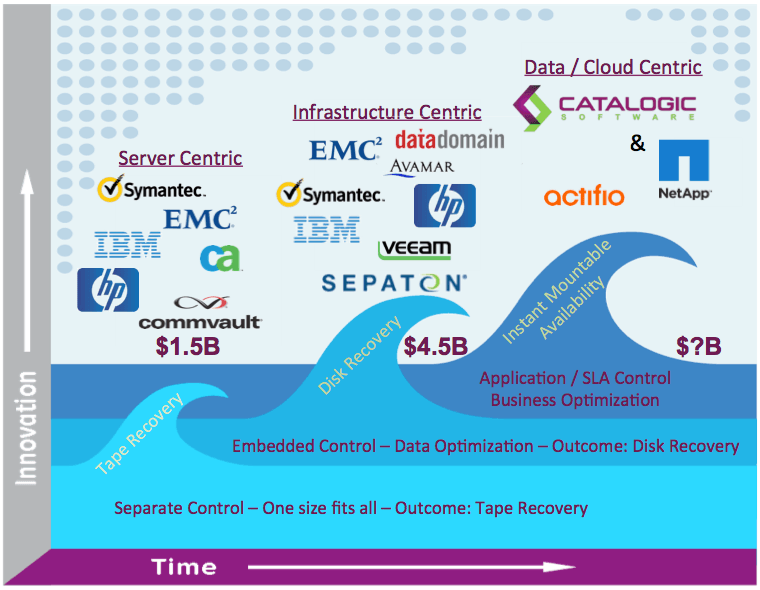So, it’s been a little bit of time since the last post. As you may have seen, I have taken on a new role as the VP of Marketing and Strategy at Catalogic Software, so things have been a bit busy here the last few weeks.
First, Catalogic Software is a private equity buy out of the larger entity Syncsort who has been around since 1968 – the year I was born. During their life, around 1996, they invented a technology, yet another backup product, but it is actually quite unique. The premise then, based on the patents, was to be able to provide instantly mountable data sets for the purpose of analytics (analytics being a big part of Syncsorts business), however, this premise is also key for data recovery given peoples heart burn with RTOs (recovery time objectives). Over time they exclusively partnered with NetApp driving all data from heterogeneous platforms to a NetApp platform. This actually makes a lot of sense. NetApp has been talking about using snapshots as a data recovery method (both local and remote) since the days when I was an analyst with ESG. By moving the data to the NetApp platform, the data, once inside could be snapped for retention purposes, vaulted for off box purposes, mirrored for DR purposes and locked for compliance purposes. From a recovery perspective, data is available through instantly mountable data access and data protection, disaster recovery RTOs are easily met. So if this is the case, why aren’t more people doing this?
And the even bigger question is, having been in the data protection space for over 15 years, why do I think this is impressive and why do I think that ‘yet another backup technology’, Catalogic Software is a great career choice?
Having been in the data protection space for 15 years, I am always interested in a better way to do things. In 2006 it was source-based deduplication. No one else had the level of technology that Avamar had then. The ability to reduce backup windows by 10x and save over 10x in storage capacity, it was unheard of.
Additionally, over the last 7 or 8 years we have heard more and more about backup being broken. I ask, do we EVER think it will be fixed? The reality is, as time moves forward, more and more people are thinking about how to move “protection” closer to the application, removing all of the mundane processes that go with traditional backup. Protection today is near instant. Data access also needs to be near instant and it is not just for recovery any longer. I need access to data for many business operations. Compliance, Test & Development, Big Data and Analytics are all great reasons to be able to have available the latest version of your data. Each of these business operations that leverage the latest and greatest data gives the business better visibility into what is going on right now and allows them to make better business decisions.
So enough about all the other things that snapshots are good for, it is crystal clear that the first use case for “copy data” is for data recovery. In fact, in a recent Gartner questionnaire, 38% of the folks asked (n=234), stated that they will be replacing their traditional backup with snapshotting, see figure 1.

The reality is IT is entering a new wave when it comes to data recovery, see figure 2. We always used to say, its all about the recovery, but no vendor ever did that really well, all the new solutions were about masking the inefficiencies of tape, while at the same time leveraging the same infrastructure (backup software, media servers, etc…) that was in place before. We actually created a $4.5B business just to hide the fact that tape wasn’t great. (Don’t get me wrong, tape does have its place, but it is not for data recovery, more for long term retention.)

In the mean time, folks started utilizing more and more storage services such as snapshotting for fast data accessibility.
The fundamental reason why more folks don’t use snapshots for data recovery is they don’t know what data they really have. Primary storage administrators set up some snapshot policies because they know that they want to have recovery points, but they may not know the application well enough to know what policies to put in place. The backup administrator doesn’t deal with the snaps because they are on primary storage, so when it comes time for a recovery, they just don’t know where the right data is so they go back to what they know, disk or tape based recovery. If you are lucky enough to have the storage admin also be the backup admin, maybe for the last 24 hours they know what data is where, but for the most part, they don’t.
The main reason why folks go back to what they know to do recoveries, the catalog (and hence the name of the company, Catalogic). With a catalog, IT can find the data they need to make the data available. With Catalogic, you can create a catalog of all of your snapshot data, snaps, vaults, mirrors etc… and make it available, not through a timely “restore” but from an instantly mountable access point. The Catalogic software is modern, build on a MongoDB, scales and provides visibility, insight and control over all of your snapshot data and VMware data without having to build and maintain a separate, complex backup infrastructure. Knowing this, WHY would you ever buy another PBBA or VTL or more tape, ever again?
My opinion, this will revolutionize the way data recovery (more importantly, data access) is achieved and I am excited to be on this train.
